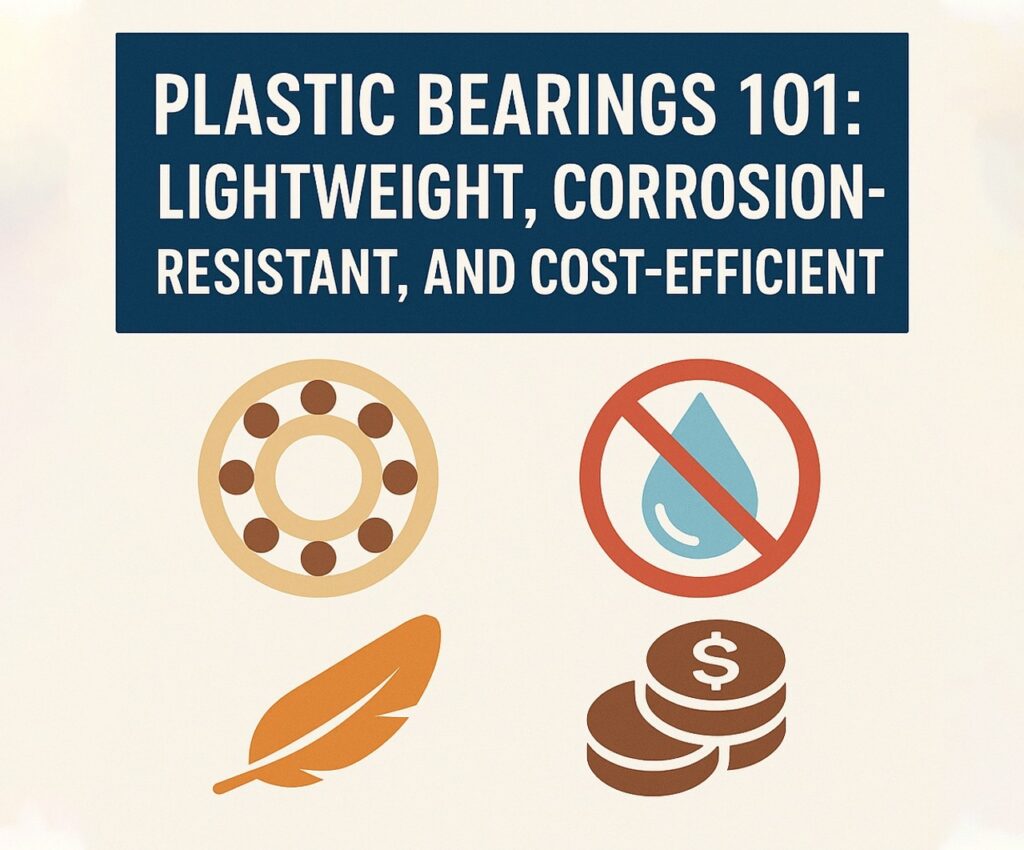In today’s fast-evolving world of material science and engineering, plastic bearings, plastic ball bearings, and plastic sleeve bearings are proving to be game-changers in a wide range of applications. These bearings, once dismissed as secondary to their metal counterparts, are now taking center stage in industries that demand lightweight construction, superior corrosion resistance, and cost-efficiency. From automation to medical devices to food processing, the rise of plastic bearings is rewriting the rules of mechanical design. Know More
What Are Plastic Bearings?
Plastic bearings are bearing systems made primarily from high-performance polymers instead of traditional metals like steel or bronze. They are designed to reduce friction between two moving parts and are available in many configurations, including plastic ball bearings and plastic sleeve bearings.
- Plastic ball bearings: Feature polymer balls and races, ideal for low-friction, high-speed applications.
- Plastic sleeve bearings: Also called plain bearings, these use a simple cylindrical shape to support axial or radial motion without rolling elements.
The big draw? These bearings offer excellent resistance to chemicals, moisture, and wear, all while weighing significantly less than metal alternatives.
Why Go Plastic?
Here are the standout benefits of choosing plastic bearings over traditional options:
- Corrosion Resistance: They resist rust, chemicals, and acids—perfect for harsh or wet environments.
- Lightweight: On average, they are 80% lighter than metal bearings, reducing overall machine weight.
- Self-Lubricating: Many plastic sleeve bearings come with built-in lubricants, reducing maintenance.
- Cost-Effective: Lower material and manufacturing costs make them affordable even at scale.
- Quiet Operation: Great for environments that demand low noise, such as consumer electronics and medical devices.
Creative and Emerging Applications
Let’s go beyond the obvious and look at innovative uses of plastic bearings:
1. 3D Printers and Desktop Robotics
Precision machines like 3D printers benefit from the reduced weight and smooth motion of plastic ball bearings, allowing for faster movement and quieter operation.
2. Food and Beverage Equipment
Thanks to their resistance to moisture and ease of cleaning, plastic sleeve bearings are increasingly used in conveyor systems, mixers, and packaging lines.
3. Medical Devices
Non-magnetic and biocompatible options make plastic bearings ideal for MRI machines, surgical robots, and infusion pumps.
4. Marine and Outdoor Equipment
Boats, kayaks, and even outdoor furniture use plastic ball bearings that won’t corrode in saltwater or humid conditions.
5. Space and Aviation
Low outgassing polymers make plastic sleeve bearings suitable for high-altitude drones and even space-bound components.
The Science Behind the Material
Modern plastic bearings are made from advanced polymers like:
- PTFE (Teflon): Excellent chemical resistance and low friction.
- PEEK: High strength and thermal stability.
- UHMW-PE: Great for low-load, high-wear applications.
- Nylon and Acetal: Common choices for general-purpose bearings.
The choice of material directly impacts properties like load capacity, temperature resistance, and wear behavior.
How to Choose the Right Plastic Bearing
Not all plastic bearings are created equal. Here’s what to consider:
- Load Requirements: Higher loads need stronger polymers like PEEK.
- Speed and Friction: Choose plastic ball bearings for lower friction at higher speeds.
- Chemical Exposure: Opt for PTFE or UHMW in aggressive chemical environments.
- Operating Temperature: Some plastic sleeve bearings can handle over 250°C, but others may soften at 100°C.
- Moisture Levels: Nylon absorbs moisture; use sealed or coated versions if needed.
Myths About Plastic Bearings (Debunked)
- Plastic bearings are weak: Advanced polymers rival some metals in strength.
- They can’t handle heat: Many modern options withstand high temperatures.
- They wear out fast: Not true when selected properly for the application.
- They’re only for light-duty use: Plastic ball bearings are used in aerospace and robotics.
These misconceptions often stem from outdated information or poor product selection.
Maintenance and Installation Tips
To get the best performance from your plastic bearings, follow these best practices:
- Avoid Over-tightening: Plastics can deform under stress.
- Clean Surroundings: Dust and grit wear down polymers faster than metals.
- Inspect Regularly: Look for signs of deformation or thermal damage.
- Install Properly: Use press fits or snap-in designs where possible.
- Consider Lubrication: Even self-lubricating plastic sleeve bearings benefit from dry film lubricants in extreme applications.
Smart Design Trends and Innovations
The future of plastic bearings is brighter than ever. Here’s where innovation is heading:
- Sensor-Integrated Bearings: Monitoring wear, temperature, and alignment in real time.
- Recyclable Materials: New formulations allow for 100% recyclable plastic sleeve bearings.
- 3D-Printed Custom Bearings: On-demand bearing prototypes reduce lead times and costs.
- Hybrid Designs: Combining polymer housings with metal cores for the best of both worlds.
Real-World Case Study: Agricultural Drone Systems
A manufacturer of agricultural drones replaced metal bushings with plastic sleeve bearings, cutting the weight of each drone by 2.4 lbs. The change improved battery life by 18% and eliminated maintenance from dirt-clogged moving parts. The high-dust, high-moisture environment proved ideal for sealed, self-lubricating plastic bearings.
Common Mistakes to Avoid
- Choosing the wrong material: Not all plastics are created equal. Match specs to the environment.
- Neglecting tolerances: Plastics expand and contract more than metals.
- Overlooking installation forces: Press fits must be precise to avoid deformation.
- Ignoring long-term wear: Even high-end plastic ball bearings need periodic replacement.
These missteps can be costly in both downtime and component failure.
Final Thoughts: Don’t Underestimate the Power of Plastic
Plastic bearings, plastic ball bearings, and plastic sleeve bearings have come a long way from their humble beginnings. No longer seen as budget or disposable parts, they are now key players in high-performance systems across industries. From cutting operational costs to enabling smarter, lighter, and cleaner designs, these components prove that polymer technology is not just an alternative—it’s often the better choice.
So whether you’re building the next generation of medical devices, scaling a food production line, or flying a drone across vast agricultural fields, consider the many advantages of plastic bearings. They might just offer the perfect blend of durability, efficiency, and economy for your next engineering challenge.

